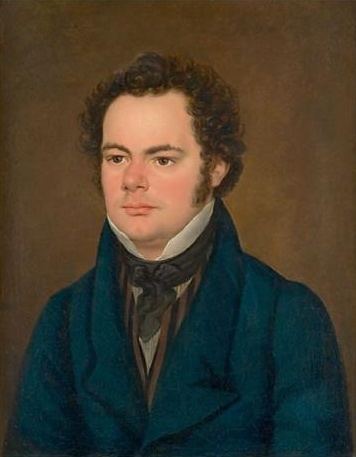 | ||
Stabat Mater in F minor, D 383, is a musical setting of the Stabat Mater sequence, composed by Franz Schubert in 1816. It is scored for soprano, tenor and bass soloists, SATB choir, 2 flutes, 2 oboes, 2 bassoons, contrabassoon, 2 french horns, 3 trombones, violin I and II, viola, cello and double bass.
Rather than setting the Latin sequence of the Stabat Mater, Schubert used a German paraphrase by F. G. Klopstock, Jesus Christus schwebt am Kreuze. The work is sometimes referred to as the Deutsches Stabat Mater, and was written for the composer's brother Ferdinand.
Schubert had written a shorter setting of the Latin Stabat Mater in 1815, Stabat Mater in G minor, D 175, a single-movement piece of approximately five minutes' duration, using only four verses of the twenty stanzas of the sequence.
Structure
This setting is essentially a short oratorio with arias, duets, trios and chorus work. The work is divided into twelve movements. Performances require 30–40 minutes.
- "Jesus Christus schwebt am Kreuze" Largo, F minor, common time; choir
- "Bei des Mittlers Kreuze standen" B-flat minor, 3/8; soprano
- "Liebend neiget er sein Antlitz" Andante, C minor, cut common time; choirThe recurring theme in the original version is based on the Kaiser Hymn. Schubert revised this later, believing it to be inappropriate.It is unknown if the allusion to the hymn was a patriotic gesture, or an homage to Haydn.
- "Engel freuten sich der Wonne" Allegretto, G minor, 2/4; soprano and tenor duet
- "Wer wird Zähren" Larghetto, G minor, 3/4; chorus (divisi)
- "Ach, was hätten wir empfunden" Adagio, C minor, common time; tenor
- "Erben sollen sie am Throne" C major, common time; chorusSchubert authorised cuts in this movement from bars 19–46, and bars 65–71.
- "Sohn des Vaters, aber leiden" Andantino, G major, 3/8; bass
- "O du herrlicher Vollender" Maestoso, E major, cut common time; chorus
- "Erdenfreuden und ihr Elend" Allegretto moderato, A major, common time; trio— "Möcht ich wie auf Adlers Flügeln"... Più mosso, C major, common time
- "Daß dereinst wir, wenn im Tode" Andante sostenuto, F major, 3/4; trio and choir
- "Amen" Allegro maestoso, F major, cut common time; chorus
